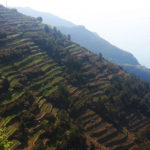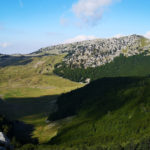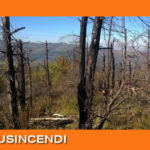Post doc position in France
Subject: Post doc position: modelling the impact of storms in the land surface model ORCHIDEE (France)
Info: Sebastiaan Luyssaert Sebastiaan.Luyssaert@lsce.ipsl.fr
Summary of post
We are recruiting for a new post-doctoral position to play a key part in building the capacity for modelling the impact of storms in the land surface model ORCHIDEE. The role is anticipated for a period of 24 months and is based at the LSCE in France. Research time needs to be spent in both France and Sweden as the successful candidate will be the integrator of this bilateral project.
Capacity building for modelling the impact of storms is an exciting development to the land surface scheme ORCHIDEE. This task will involve: (1) downscaling high resolution wind fields for two regions in Europe, (2) developing a storm module for ORCHIDEE based the existing stand-level model ForestGALES, (3) modelling the structural and functional effects of wind storms including weathering, drainage and run-off in addition to the more typical effects on stand structure and validating the simulations against existing field observations, and (4) a regional attribution study of the effects of wind storms as a function of gap size and storm frequency.
Fuller description
Although Earth System Modelling groups dedicate considerable amounts of resources studying the effects of fires, shifting cultivation and more recently logging, storms are not yet explicitly dealt with in Earth System Models. However, storm-induced disturbances are likely to feedback to the climate system through direct effects such as increasing green house gase (GHG) emissions (CO2 and CH4) and changes in the energy budget and indirect effect such as increasing fire vulnerability, logging in subsequent years, increased weathering and increased C, N and cation leaching. The overall objective of this proposal is to bold together ongoing research efforts in France and Sweden to build the modelling capacity for attributing and prediction the impacts of wind storms in the Earth system.
Evaluating the impacts of wind storms on European forests between 1990 to 2010 requires that the land surface model is forced by high resolution wind fields. Observational records allow to evaluate the ability of regional climate simulations, when forced by re-analyses, to properly simulate storms of the past 20 years. These simulations, made with the Weather Research and Forecasting (WRF) model will also be used to determine a feasible scale to which wind fields should be downscaled to obtain acceptable predictions of wind gusts.
Currently, wind throw does not contribute to tree mortality in ORCHIDEE. Depending on the wind gusts, soil condition and characteristics, tree height, stand density, and topography, a given windstorm could result in no damage, small gaps (0.01 km2). Following wind throw, gap size will determine the growing environment for the regrowth. Quality of the simulated storm impacts depends on the ability to model the relationship between gusts and gaps and subsequently the biogeochemical and biophysical changes within the gaps. The relationship between gusts and gaps will be validated by making use of satellite-derived disturbance maps. Subsequently, observed and simulated gap-size and distribution for two test regions (see WP4) will be compared. FLUXNET observations will be used to validate the carbon and water fluxes and biophysical processes taking place within the gaps. Following the heavy storms Gudrun and Kyrill, flux towers have been erected in areas affected by windthrow, these observation allow a detailed validation of GHG, water and energy fluxes.
Recently data suggest that terrestrial processes may play a much more important role in the lateral C fluxes to the oceans through inland waters than previously thought. Slight changes in flow pathways or processes may switch ecosystems from being net sinks to net sources. Another important, but so far neglected feedback, is an indirect effect on long-term C fluxes during insufficient supply of base cations through weathering. We will explore how windfall and subsequent processes will affect the fluxes of carbon and base cations using existing watershed based models for both base cation and C cycling.
Following validation, the newly acquired capacity will be demonstrated by two regional studies in Southern Sweden and South western France. These forest-rich regions were selected because, in addition to frequent small scale wind disturbance, both experienced a big storm in respectively 2005 (Gudrun) and 2009 (Klaus). First, a factorial modelling experiment will be set-up with ORCHIDEE. This approach allows to attribute a fraction (positive or negative) of the current sink to wind throw. Second, an existing coupling between ORCHIDEE and WRF will be used to study the feedback between wind-disturbance and climate. To this aim virtual disturbance maps combing gap size
distributions and storm frequencies will be developed for the test regions. Combining maps with present climate will be the starting point for climate forecasting until 2050. Such a modelling experiment will help to establish whether wind throw has a positive or negative feedback on the climate system.
Home institution
From an administrative point of view the position will be based at the Laboratoire des Sciences du Climat et de l’Environnement (LSCE, Orme-les-Merisiers, Gif-sur-Yvette, France). The successful candidate, however, will be required to spend substantial time in Sweden at SLU (Uppsala and Alnarp) and Lund University (Lund). As well as in France at the LSCE (Gif sur Yvette) and INRA (Bordeaux).
Qualifications
Given the interdisciplinary nature of the research we are seeking for a highly motivated individual with a PhD degree in for example forestry, ecology, environmental modelling or related topics. A broad interest in natural sciences more specifically terrestrial ecology and biogeochemistry is essential. Rather than for a specific training, we are looking for a candidate who is able to demonstrate her/his ability to understand coupled biogeochemical cycles and develop code (Fortran 90), publish manuscripts in peer review journals and establish and maintain communication between five researchers across two countries.
Required content of the application
Applications and inquiries should be sent to Sebastiaan Luyssaert (Sebastiaan.Luyssaert@lsce.ipsl.fr). Applications should include:
(1) a curriculum vitae,
(2) statement of motivation,
(3) a short description (½ page no more than 1 page) of a recent scientific problem you successfully solved and
(4) names, addresses, phone numbers, and email addresses of at least two references.
The position is available from September 1st and will remain open until filled with review of applications and interviews starting on April 21st. Salary follows national directives and is adjusted for work experience.
Info Autori
SAFE - Scuola di Scienze Agrarie, Forestali, Alimentari ed Ambientali
Università degli Studi della Basilicata





